 UK – 1885-90 – 4 submersibles.
UK – 1885-90 – 4 submersibles.The earliest military torpedo submarines:
WW1 British Submersibles:
Nordenfelt Class | Holland Class | A class | B class | C class | D class | E class | F class | G class | G class | H class | J class | K class | HMS Swordfish | HMS Nautilus | L Class | M class | R class | S classV class | W classIn 1886, Ottoman submarine Abdülhamid (1886) was the first in history to fire a torpedo while being submerged. Why it fell on Turkey ? It was due to a Swedish Company better known than Bofors, also of the Maxims/Vickers Empire and Hotchkiss. The firm funded by Thorsten Nordenfelt became one of the most successful arms manufacturer of the time, especially popular for their light organ guns in service on many ships, and especially torpedo boats of the 1880s. But the company also ventured on another area deemed as promising as machine-gun for future warfare: Steam submersibles, the brainchild of a reverend…
About the founder, Thorsten Nordenfelt
The Swedish inventor and industrialist was born in Örby (Kinna) in 1842, the son of a colonel, which perhaps oriented his product choices later. He moved in London in 1862 to work for a company and settled there, taking the nationality from 1867. His fist business was to trade Swedish steel for British rails in 1887, but he was advised to engage in a more profitable vnture, Nordenfelt Guns and Ammunition Company, ltd. He acquired rights from engineer Helge Palmcrantz, developed and sold the Nordenfelt gun. This was basically an organ gun with a mechanism for rapid load/fire by lever action. From this success, he moved to torpedo boat guns of calibers 37 to 57 mm, also produced in Erith, Kent, Stockholm and Spain. It was during this period in 1882-85 which he helped setting up a new venture with submarines in Stockholm, bearing his name.
However he was later pressured by Rothschild and Vickers to merge his company in 1888 to Maxim, entering the “machine gun empire”. The new company, now called Maxim Nordenfelt Guns and Ammunition Co., but he had to quit after a personal bankruptcy. He moved to France and started a new business, Société Nordenfelt, designing the eccentric screw breech used on the famous French 75 field gun. After a long trials with his former British company he retired in Sweden in 1903. He passed out in 1920 (aged 77) in Stockholm.
The saga of Nordenfelt guns
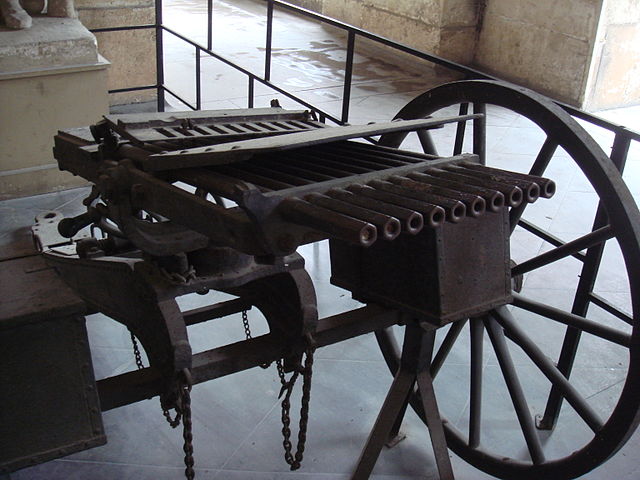
A Nordenfelt 1880s 10-barrelled naval pivot gun
This chapter is relevant here about the company and the man behind, about the guns that found their way on so many torpedo boats and light vessels of the Royal Navy and many others. He was in short a rival to Hotchkiss in the 1890s, but by then his guns were no longer in demand. The patented gun was in short an organ gun, not a machine-gun. The distinction is important, as the latter fired bullets in succession, and basically followed the lineage of the Gatling gun, and long before that, the experimental puckle gun while the Nordenfelt model followed the organ gun, first developed by Leonardo da Vinci and used notably by the Ottoman Empire.
The principle was to fire volleys of rounds, not successive bursts. Therefore it was much heavier due to the multiple barrel configuration. Perfect for colonial wars of the 1880s as it would fire volleys after volleys with devastating effect, as long as there were at least two loaders, it came with a similar carriage to those used on field guns, carried by artillery. Like for early machine guns in the late 1860s and 1870s, there was no clear doctrine yet of how to properly use them. They were often deployed at long range like artillery rather than follow the infantry closer in its advance. By virtue of its weight, it was in various navies, this gun found its place. The nature of the gun meant dispersion of bullets or shells was considerable and therefore accuracy rather poor.
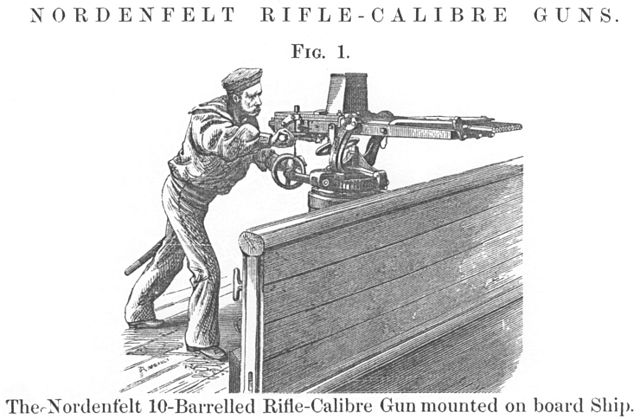
The 1873 patent of Swedish engineer Helge Palmcrantz.
The 1873 Palmcrantz gun as it was known first rested on a mechanism to load and fire the multiple barreled gun. A simple single lever backwards and forwards made both operations. Thorsten saw it in an exhibition was keen to promote a fellow Swedish engineer. However as it produced it, the device was renamed Nordenfelt gun. Development to market took years, and the sales offices was based in London while demonstrations were made through Europe and in the USA as well. The Royal Navy soon found an utility for it and adopted it, alongside the Gatling and Gardner guns already in use. The latter was also from an American inventor based in Ohio and probably more advanced as it relied on a stripper clip.
The simplicity of the Nordenfelt gun however authorized a cheaper production and scaling-up as Thorsten convinced the inventor to increase the caliber of one inch to make it suitable for the Navy. This simplicity also induced reliability, with 3,000 rounds of ammunition fired in 3 minutes and 3 seconds without stoppage or failure, whereas most MGs at that time regularly jammed. This was probably one of the most appealing feature of the system to Navies and armies alike. It was used by Argentina, Austria-Hungary, Brazil, Chile, China, France, the Philippine Republic after 1898, Portugal, Spain, Turkey, the UK and US, or Uruguay for example.
The Maxim gun however proved superior and through the intermediation Basil Zaharoff, Nordenfelt joined in and a merger was decided 1888, to mass produce the Maxim. The Nordenfelt mopdels weanwhile were popular in the 1880s and early 1890s, thanks to Zaharoff, but started to disappear prior to WW1 and appeared as a reserve gun at best, used only by some second-rate armies. In 1905 for example, both the Russians and Japanese used more conventional models, Maxims for the Russians, for the Japanese.
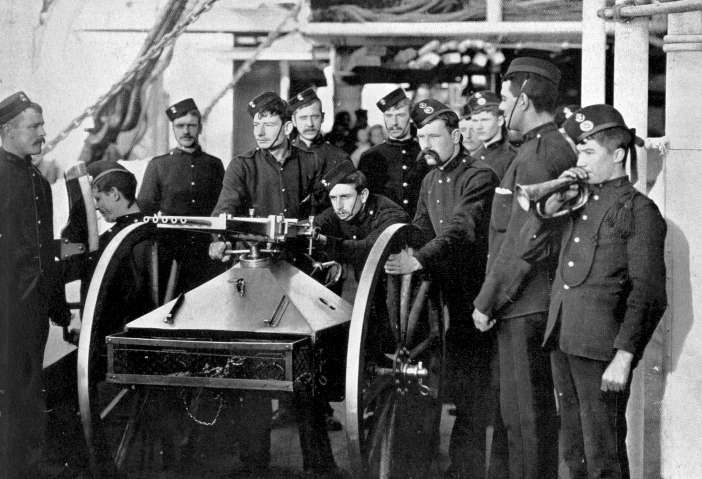
Royal Marines testing a Nordenfelt 5-barrel rifle in 1890.
Development of Nordenfelt submarines
Thorsten Nordenfelt’s “submarine adventure” started on completely new promises. There was no link nor appeal from the sea but a meeting in London with reverend George Garrett led to the production of a series of steam-powered submarines.
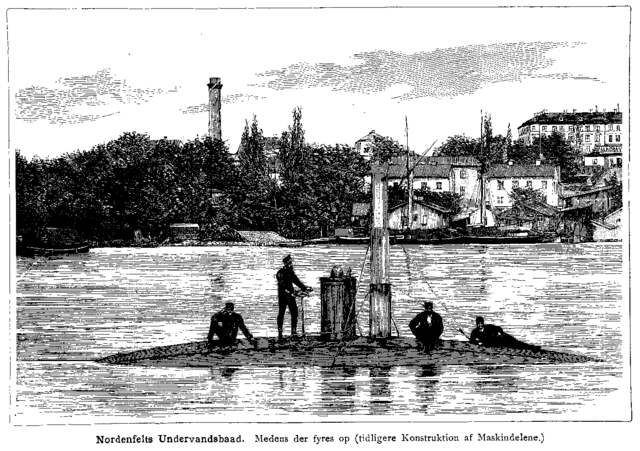
About reverend George Garrett:
It’s unusual for a preacher and man of peace to be the brainchild of a dreaded weapon of war. The British reverend born in Manchester, Lancashire, in 1852, the son of an Irish-born Church of England curate learned Chemistry and sciences at Owens, Trinity College, Dublin. He worked with the Manchester Mechanics’ Institute where he obtained a BA. However in 1873 he passed the Cambridge Theological Examination and became a curate in his father’s parish. Nevertheless, he never left aside his passion for science and was especially interested in submarine tech. In 1877 her patented a diving suit, demonstrated to the French government in the River Seine in Paris.
He followed suite by attempting to create the first submarines, a Manchester Businessman funding £10,000 to create the Garrett Submarine Navigation and Pneumataphore Company Limited. The pneumataphore was used for removing carbon dioxide, an essential contraption developed for an autonomous diving suit and later submarines, as it was quite large.
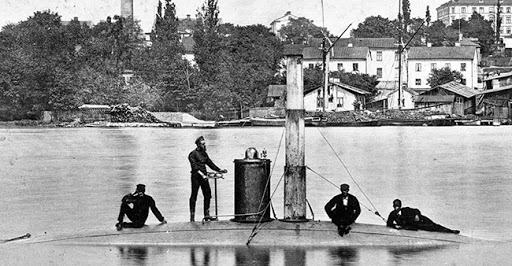
British submarine pioneer George Garrett (with bushy beard) at the helm of a Nordenfelt submarine boat in the Baltic during the 1880s. Photo: US NHHC.
About the Resurgam Submarines
Resurgam I
But overall, in 1878, the reverend was famous for building a 14-foot (4.3 m) long hand-cranked submarine. Weighting about 4.5 tons, the Resurgam had a peculiar shape, cylindrical in the middle and conical at both ends. It was inspired by the USS Alligator of 1864 and other civil war and European projects of the time.
Resurgam II
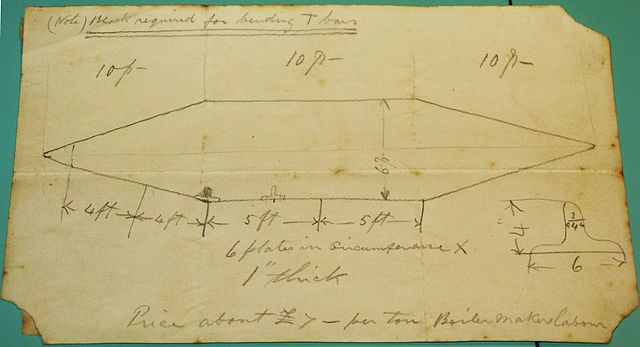
The second and arguably way more famous “Resurgam” of 1879 was 45 feet (14 m) long, for 30 tons/38 tons surface/submerged. It was made famous for one point: It was steam-powered. Not the world’s first, arguably the CSS David was already a kind of “semi-submersible”. Its furnace and unique funnel were simply shut off before diving. The interesting point was this closed cycle steam engine patented in 1872 by the American engineer Emile Lamm authorized a four hours autonomy underwater. Also, it had positive buoyancy, and diving hydroplanes amidships.
Construction of the Resurgam tool place at the Cochran and Co, Birkenhead, Merseyside with iron plates on iron frames.
It was launched on 26 November 1879 and tested in East Float at Wallasey with success, but later was shown to the RN, and proved to not be practical as the boiler was not separated from the rest of the interior, and superheated water made conditions unbearable inside. The boat also had longitudinal stability problems which were hard to solve. It made a long crossing on 10 December 1879, with Garret and Jackson as skipper and Price as engineer, bound for Portsmouth, where it made its engineering trials, and was prepared for its first RN official sea trials. However on 25 February 1880 while in tow, the Resurgam sank in Liverpool Bay. The main reason was that its entry hatch could not be fastened from the outside and water sipped in gradually, until it capsized and sank.
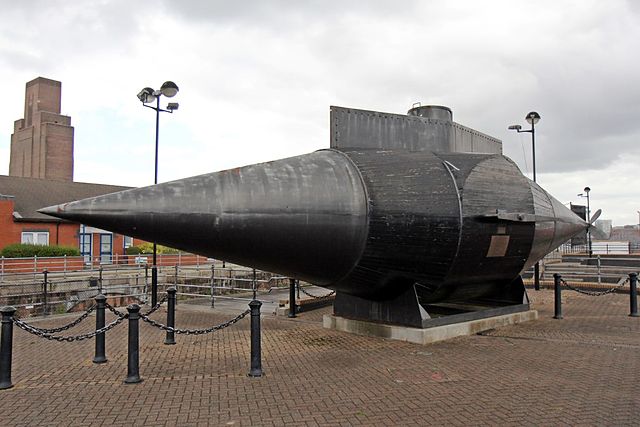
The hulk was rediscovered in 1995, but not refloated. A replica is now in display in Woodside, Birkenhead
Meeting with Nordenfelt
Despite the fact the Resurgam was lost whilst under tow near Rhyl to lake its official Royal Navy trials in Portsmouth, Thorsten Nordenfelt was impressed by the demonstration and concept.
Before this, Zharoff had acquired Isaac Peral’s submarine patent, and talked to Nordenfelt, convincing him to start a submarine business. Later Peral would met Thorsten N. in London but failed to find an agreement. Meanwhile, Garrett’s submersible, despite its unreadiness, was pushed forward commercially.
Both men found an agreement and Nordenfelt agreed to finance him, with Zaharoff as the selling force. Production of the first model commenced despite the fact the first model was faulty and unproven at that stage: As a US Intelligence officer put it, this was a contraption capable of “dangerous and eccentric movements.”
A Swedish industrialist, a British Reverend and a Greek arms dealer are in a boat…
Meanwhile Zaharoff managed to sell one to Greece and two for Turkey, long-term well known enemies. The shrewd Zaharoff even managed to make the Reverend Garrett commissioned as a Commander in the Imperial Ottoman Navy (a reverend in Islam !) for carrying out trials, when they were delivered. Soon, Garrett showed how much his models were defective: Both subs suffered from severe stability problems, despite the fact one later fired successfully a torpedo, sufficient to impress the court. Later, convincing Russia that it would need to defend itself from this new Ottoman threat, Zaharoff also managed to sell one to to Imperial Russian Navy: A single one was built for evaluation, but ran aground off Jutland on its way to St Petersburg. The Russians naturally refused to pay for it. Already since 1877 they were moderately pleased with Drzewiecki’s designs.
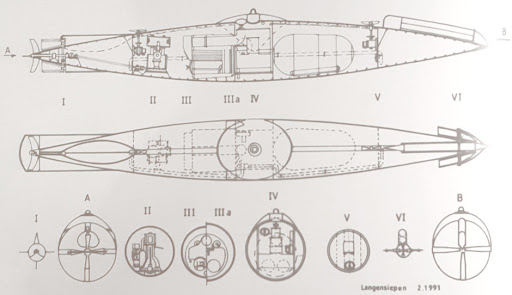
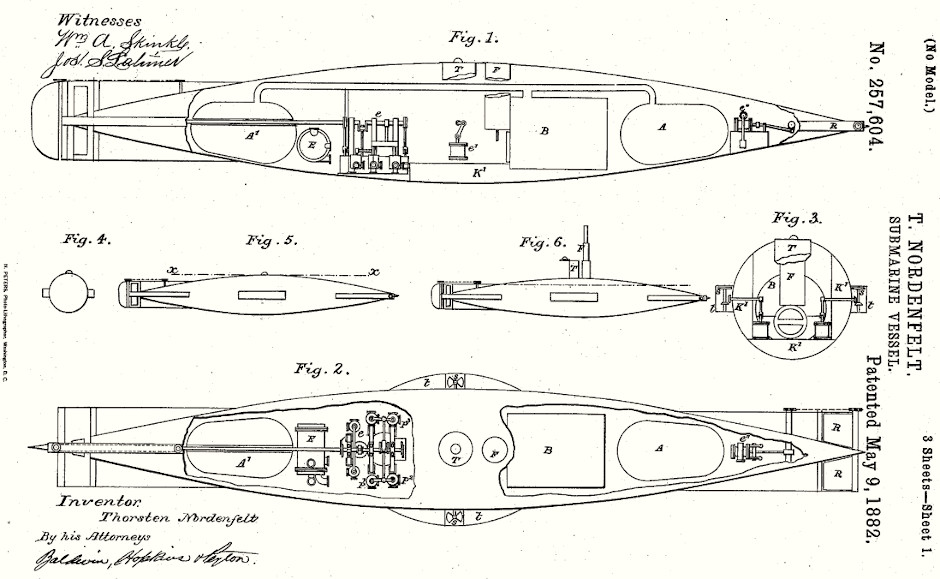
Design of Nordenfelt submarines
Nordenfelt I, the first Greek submersible
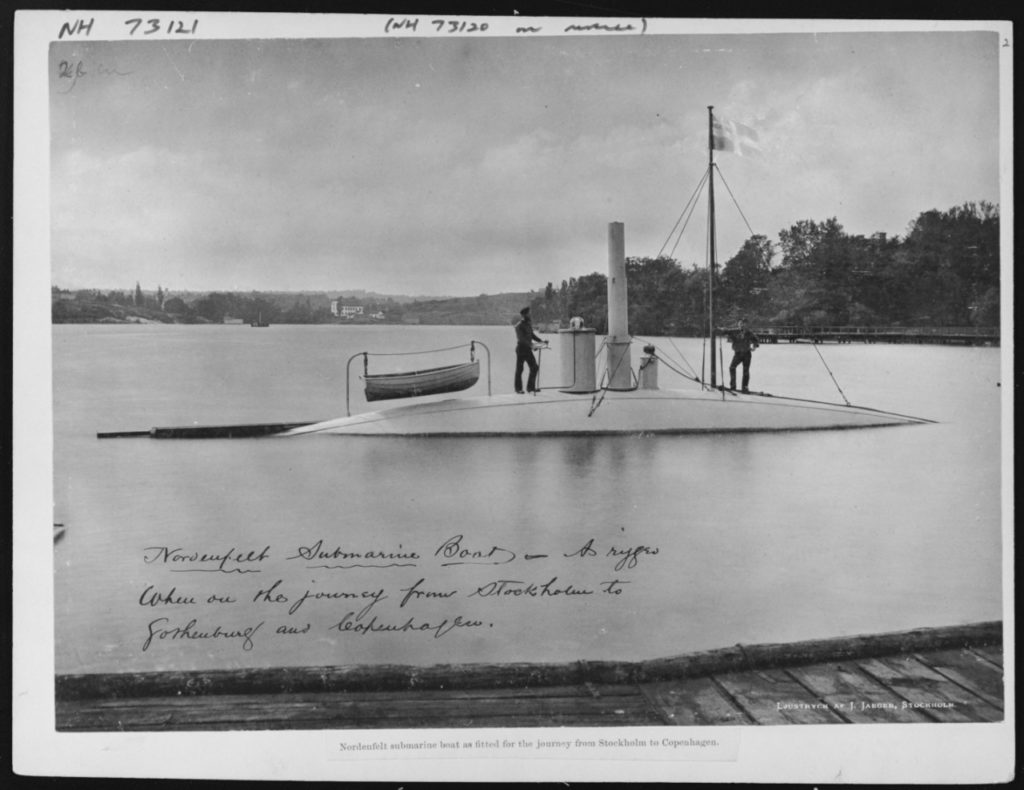
The Nordenfelt I built for Greece in trials off Stockholm – history.navy.mil
The Nordenfelt I was a 56-tonne, 19.5-metre long vessel based on the Resurgam of 1879. It had an improved range of 240 km, and was armed with a single torpedo and naturally a 25.4 mm Nordenfelt machine gun. Bolinders in Stockholm was contacted for the manufacturing, and the submersible was built between 1884 and 1885. The N°1 was a pure submersible, first and foremost operated from the surface, thanks to a 100 HP steam engine, fed by a coal-fired boilers, procuring the modest speed of 9 knots. It was shut down when diving as the smokestack was collapsible. The idea was there was still sufficient steam remaining inside the boilers to procure some speed underwater. The ballasts were filled or purged by pumps not electrically, but also by using steam, and there were two vertically-acting screws over the deck to make the sub plunging or surface quicker.
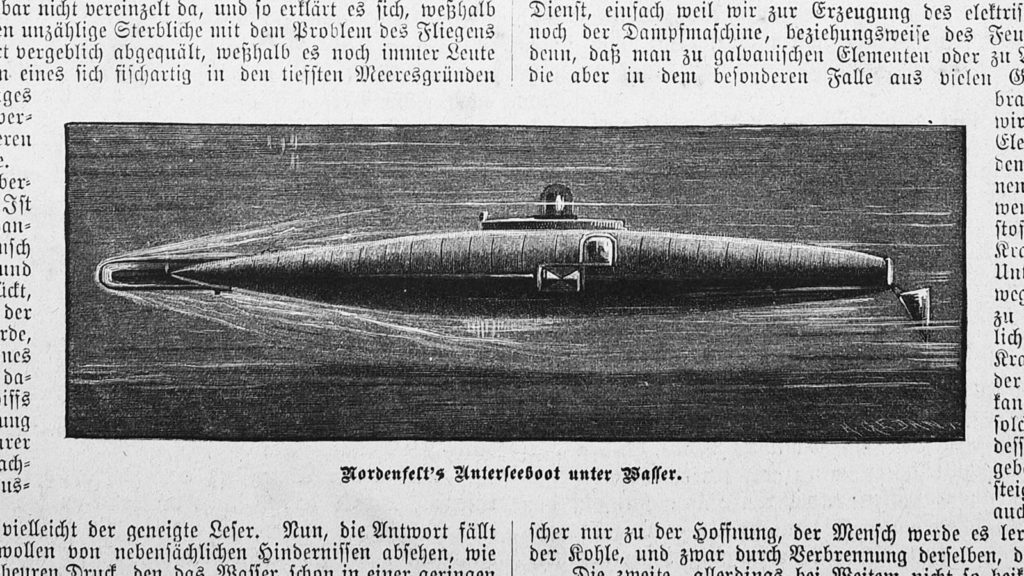
Extract from a German science publication
The Nordenfelt I was demonstrated to an international gathering, but only smaller nations showed some interest. Trials indeed took place in September 1885 in Stockholm, Landskrona base, attended by crowned heads as well, and 35 naval and military officers from all countries. She had been originally built for Greece, and was effectively purchased by the Greek Government, delivered to Salamis Naval Base in 1886. There, she made acceptance tests, but when underwater shown each time a crucial lack of longitudinal stability. She was never used operationally by the Hellenic Navy, which mothballed and scrapped her in 1901.
Nordenfelt II/III, the first Turkish submersibles
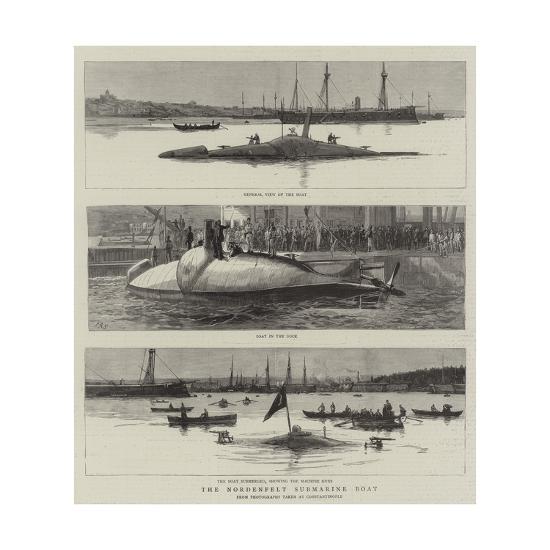
Nordenfelt-II-publication-extract
Surfing on the positive returns of his model in official trials and PR efforts by Zaharoff, Nordenfelt was persuaded to start two more, much larger for the Ottoman government. They were built as the Nordenfelt N°2 and 3 or in Roman numeral II and III. The first was named Abdül Hamid in 1886 and the second Abdül Mecid, the next year in 1887. Both were 30 meters long submarines (100 feet and displacing 160 tons), this time with twin torpedo tubes. But the basic principled remained the same. They were built not at Barrow-in-Furness, but in parts made by Des Vignes (Chertsey) and Vickers (Sheffield) in England, conveyed by ships and reassembled at the Taşkızak Naval Shipyard in Istanbul.
Abdul Hamid was launched on September 6, 1886 in front of many international dignitaries lined along Golden Horn. After fitting out, the first diving tests started in February 1887. Three dives were successfully of around 20 seconds each. Only the hemispherical navigator cockpit remained above water. In early 1888, the submarine was tested through the strong currents around the Seraglio Point. Abdul Hamid proved capable of making 10 knots and, arriving semi-submerged, and then fully submerged, sank an old target ship by firing a single torpedo, a world’s premiere achievement. She underwent more tests and trials at Izmit naval base, and officially joined the Ottoman Navy on 24 March 1888. Soon, this was the case for the second model.
Off the golden horn, these subs showed their usefulness when operating on surface or semi-submerged like the CSS David, but when submerged fully this was another story. Their steam-driven approach proved to be completely inadequate for underwater navigation. Chronically unstable, they failed in simple underwater manoeuvers other than staying in a straight line, but at least were successful for firing a torpedo: Indeed Abdül Hamid became the first military submarine in history to do so and that would remain the only redeeming point for these forgotten submarine today.
Abdülhamid and Abdülmecid were still listed active in the Ottoman fleet, based in Istanbul in 1914. They were briefly used as harbour defence vessels, but their hulls were already too badly corroded for effective service.
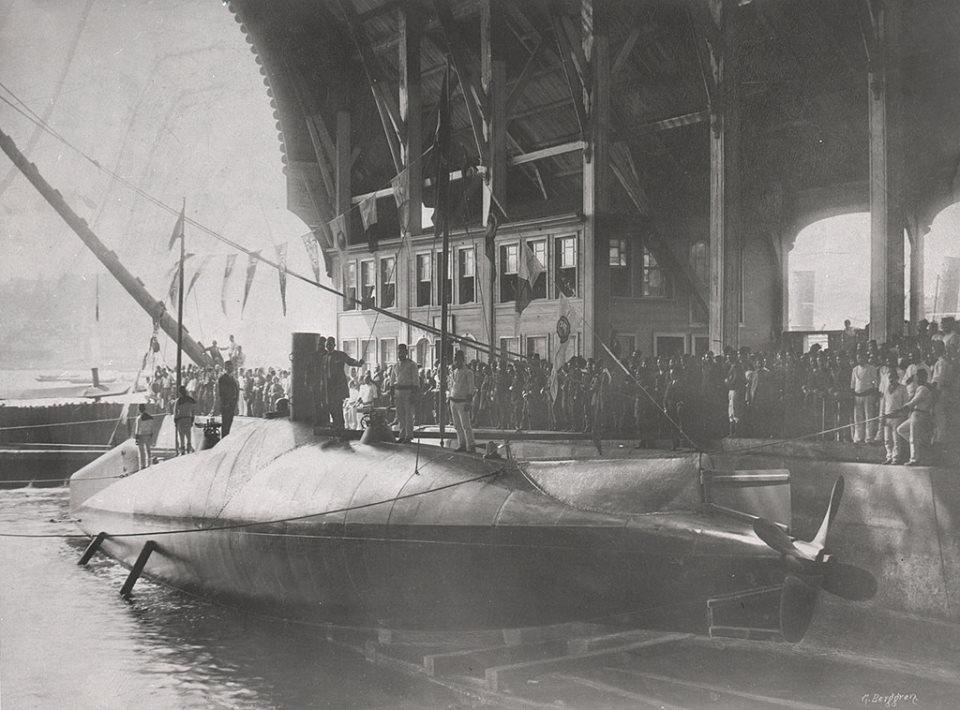
Launch ceremony of the Abdülhamid
Nordenfelt IV
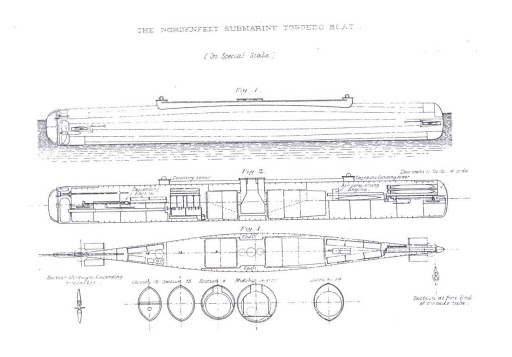
Nordenfelt’s efforts culminated in 1887 with the Nordenfelt IV, an enlarged version with twin steam engines and two torpedo launchers. Sold to the Russians, it proved unstable as always and ran aground off Jutland, lost. The Russians learned it and refused to pay for it, therefore the vessel was salvaged and sold for scrap locally. The N°4 was 125 feet for a beam of 12 feet and an estimated submerged displacement of 245 tons, 230 tons in surface. Its hull shaped resembled more a conventional ship, and she achieved 14 knots, which was the best performance by a sub so far in 1887. She had two funnels. As a semi-submerged torpedo boat it had even more military value than conventional surface torpedo boats, if used at night in the right conditions.
Extract from the Earliest Ages to the Present Day, Lt. Col., Brevet-Col. Cyril Field, Royal Marine Light Infantry. Published in J. B. Lippencott of Philadelphia, 1905 Pg. 126-130:
“But Nordenfeldt made up his mind to build yet another and a still larger submarine. This one was built at Barrow-in-Furness and, fully equipped, had a displacement of 245 tons. She was quite a different shape from her predecessors. She was 125 feet long and 12 feet in diameter amidshipship. But her was the only portion of her that was round in section, as she got flatter and flatter forward and abaft till she ended in vertical knife-edges. Her deck and two conning-towers were covered with one-inch steel armour, which would have made her impervious to all machine guns of that period when running awash. Her horizontal propellers for immersion worked in recesses cut in the stem and stern. She had a crew of a captain, mate, two seamen, an engineer, his assistant, two fireman, and a cook. Her means of propulsion were similar to those employed in the other Nordenfeldt boats, but her engines were more powerful, being of 1000 i.h.p. giving her a surface speed of 15 knots under favourable conditions, and a speed of 5 knots when submerged. She, however, suffered from the same want of horizontal stability as her elder sisters, and her trials in the Solent were not at all encouraging. She had been built for the Russian Government, and despite the unsatisfactory nature of her performance she was despatched to St. Petersburg. But she never got there, as she was wrecked on the coast of Jutland on September 18, 1888.“.
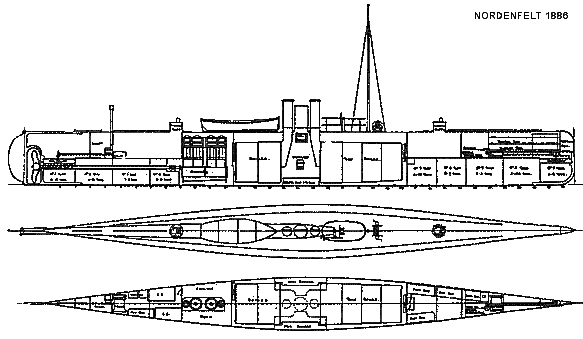
Nordenfelt’s bankruptcy
The picture which emerges of Nordenfelt’s submarines overall it that they were not particularly successful. When operating close to surface they proved fast and can manoeuvre, but when fully submerged they proved almost useless, impossible to steer properly and with a limited autonomy due to all power coming solely from remaining steam. As a means of emergency diving procedure only however it turned out a step forward in general submersible development, but this well-publicized model and international coverage of these failures however did not helped the cause of the submarine.
Further south in Spain, Isaac Peral’s model was far more promising but plagued by the lack of funding. In France in 1886, Gustave-Zédé’s Gymnote embraced the all-electric solution but was still not considered the way forward. The next decade, the 1890s, however would prove more successful. Failing to rally to his cause Peral, Nordenfelt’s expanses for the failed submarines bankrupted his company, soon part of the Vickers Armstrong empire. He was pushed out by the staff in 1890 and returned to Sweden.
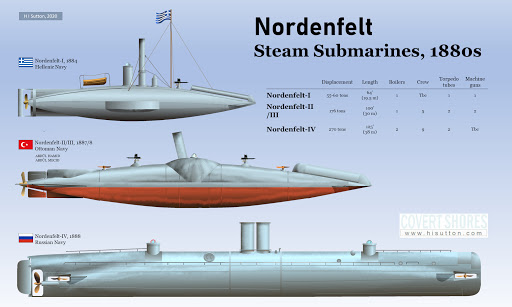
There is a complete article about the Nordenfelt submersibles by expert HI Sutton with wonderful 2D and 3D reconstructions, warmly recommended.
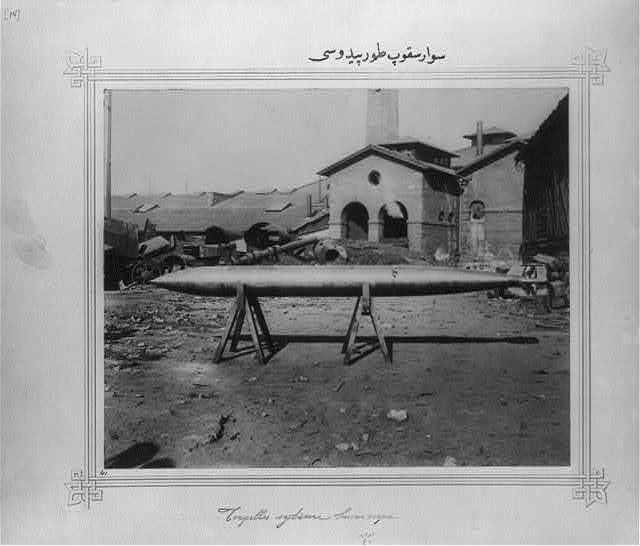
Torpedo of the Abdul Hamid (cc).
Read More/Src
//en.wikipedia.org/wiki/George_Garrett_(inventor)
//en.wikipedia.org/wiki/Thorsten_Nordenfelt
//en.wikipedia.org/wiki/Basil_Zaharoff
//militaryhonors.sid-hill.us/history/gwmjh_archive/Competition/Nordenfelt_IV.html
//www.hisutton.com/Nordenfelt-submarines.html
//iainballantyne.com/long-voyage-of-puny-boats-to-becoming-the-mightiest-vessels-of-war-ever-seen-or-rather-unseen/
//en.wikipedia.org/wiki/Ottoman_submarine_Abd%C3%BCl_Hamid
//rnsubs.co.uk/boats/nordenfelt.html
//www.lutonmodelboat.co.uk/Vickers/Vickers%20SubmarinesNew.pdf
James Packer ‘Bexley Pubs’ ISBN 0902541331
THE ORIGINS OF THE OTTOMAN SUBMARINE FLEET by K. ZHUKOV and A. VITOL
Vice Admiral C. Paizis-Paradellis, HN (2002). Hellenic Warships 1829-2001 (3rd Edition). Athens, Greece: The Society for the study of Greek History. p. 133. ISBN 960-8172-14-4.
Submarine Heritage Centre – submarine history of Barrow-in-Furness
Preston, Antony (2001). The Royal Navy Submarine Service: A Centennial History. Conway Maritime Press. p. 19. ISBN 0-85177-891-7.

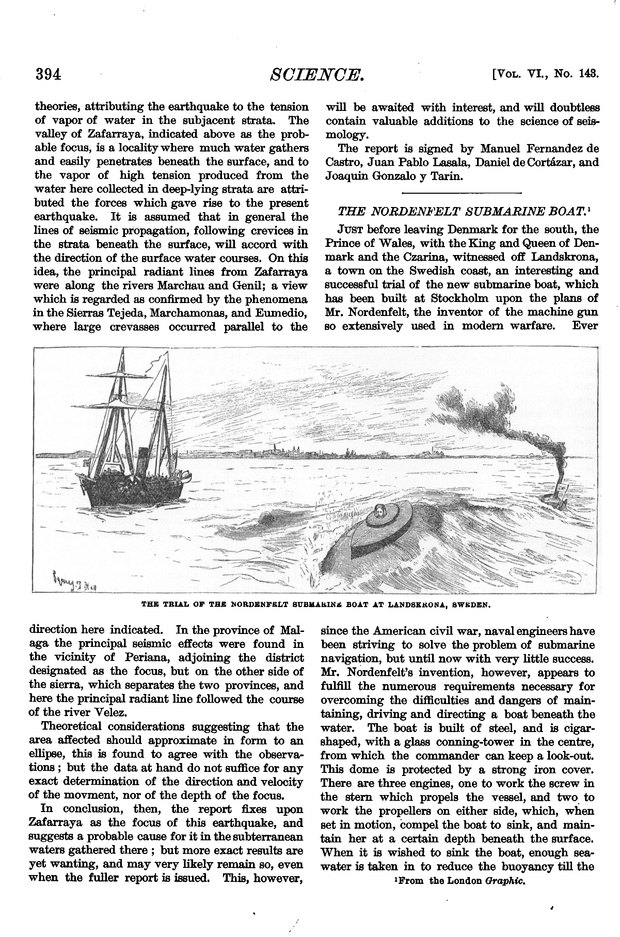
 Latest Facebook Entry -
Latest Facebook Entry -  X(Tweeter) Naval Encyclopedia's deck archive
X(Tweeter) Naval Encyclopedia's deck archive Instagram (@navalencyc)
Instagram (@navalencyc)





 French Navy
French Navy Royal Navy
Royal Navy Russian Navy
Russian Navy Armada Espanola
Armada Espanola Austrian Navy
Austrian Navy K.u.K. Kriegsmarine
K.u.K. Kriegsmarine Dansk Marine
Dansk Marine Nautiko Hellenon
Nautiko Hellenon Koninklije Marine 1870
Koninklije Marine 1870 Marinha do Brasil
Marinha do Brasil Osmanlı Donanması
Osmanlı Donanması Marina Do Peru
Marina Do Peru Marinha do Portugal
Marinha do Portugal Regia Marina 1870
Regia Marina 1870 Nihhon Kaigun 1870
Nihhon Kaigun 1870 Preußische Marine 1870
Preußische Marine 1870 Russkiy Flot 1870
Russkiy Flot 1870 Svenska marinen
Svenska marinen Søværnet
Søværnet Union Navy
Union Navy Confederate Navy
Confederate Navy Armada de Argentina
Armada de Argentina Imperial Chinese Navy
Imperial Chinese Navy Marinha do Portugal
Marinha do Portugal Mexico
Mexico Kaiserliche Marine
Kaiserliche Marine 1898 US Navy
1898 US Navy Sovietskiy Flot
Sovietskiy Flot Royal Canadian Navy
Royal Canadian Navy Royal Australian Navy
Royal Australian Navy RNZN Fleet
RNZN Fleet Chinese Navy 1937
Chinese Navy 1937 Kriegsmarine
Kriegsmarine Chilean Navy
Chilean Navy Danish Navy
Danish Navy Finnish Navy
Finnish Navy Hellenic Navy
Hellenic Navy Polish Navy
Polish Navy Romanian Navy
Romanian Navy Turkish Navy
Turkish Navy Royal Yugoslav Navy
Royal Yugoslav Navy Royal Thai Navy
Royal Thai Navy Minor Navies
Minor Navies Albania
Albania Austria
Austria Belgium
Belgium Columbia
Columbia Costa Rica
Costa Rica Cuba
Cuba Czechoslovakia
Czechoslovakia Dominican Republic
Dominican Republic Haiti
Haiti Hungary
Hungary Honduras
Honduras Estonia
Estonia Iceland
Iceland Eire
Eire Equador
Equador Iran
Iran Iraq
Iraq Latvia
Latvia Liberia
Liberia Lithuania
Lithuania Mandchukuo
Mandchukuo Morocco
Morocco Nicaragua
Nicaragua Persia
Persia San Salvador
San Salvador Sarawak
Sarawak Uruguay
Uruguay Venezuela
Venezuela Zanzibar
Zanzibar Warsaw Pact Navies
Warsaw Pact Navies Bulgaria
Bulgaria Hungary
Hungary

 Bundesmarine
Bundesmarine Dutch Navy
Dutch Navy Hellenic Navy
Hellenic Navy Marina Militare
Marina Militare Yugoslav Navy
Yugoslav Navy Chinese Navy
Chinese Navy Indian Navy
Indian Navy Indonesian Navy
Indonesian Navy JMSDF
JMSDF North Korean Navy
North Korean Navy Pakistani Navy
Pakistani Navy Philippines Navy
Philippines Navy ROKN
ROKN Rep. of Singapore Navy
Rep. of Singapore Navy Taiwanese Navy
Taiwanese Navy IDF Navy
IDF Navy Saudi Navy
Saudi Navy Royal New Zealand Navy
Royal New Zealand Navy Egyptian Navy
Egyptian Navy South African Navy
South African Navy






























 Ukrainian Navy
Ukrainian Navy dbodesign
dbodesign